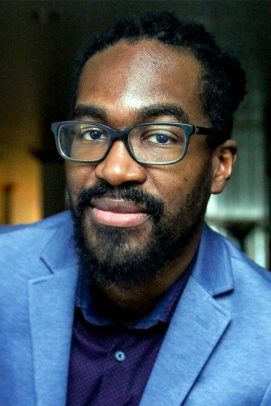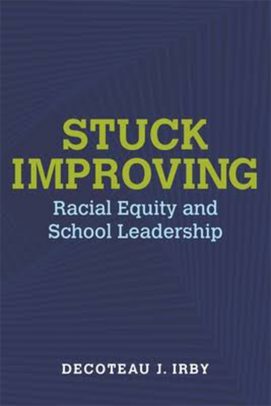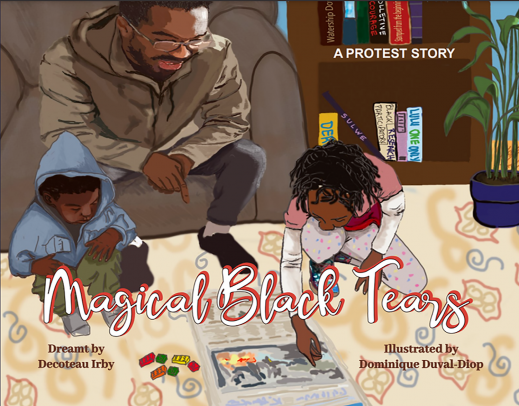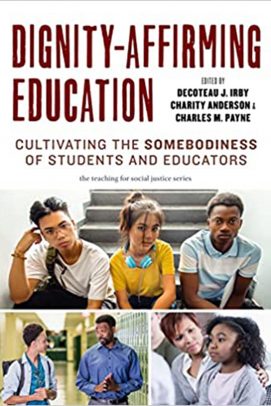UIC educational policy scholar searches for social, racial justice

Decoteau Irby, an associate professor in the University of Illinois Chicago College of Education, recently published two books that may seem dissimilar, but both find their roots in the same place: social and racial justice.
Irby, associate professor of educational policy studies, is the author of two books released in 2021, “Stuck Improving Racial Equity and School Leadership,” published by Harvard Education Press, and “Magical Black Tears: A Protest Story,” a children’s picture book illustrated by Dominique Duval-Diop and published by Derute Consulting Cooperative. A third book that he co-edited, “Dignity-Affirming Education: Cultivating the Somebodiness of Students and Educators,” is scheduled to be published April 22 by Teachers College Press.
At UIC, Irby teaches and advises primarily in the urban education leadership doctoral program. He teaches educational leadership, organizational change and school improvement using pedagogical approaches grounded in action research, team-based inquiry and active learning. His research focuses on how leadership improves Black students’ academic achievement and socio-emotional well-being across the K-12th grades.
Irby, who is director of the Call Me MISTER initiative at UIC, joined UIC in 2015 after receiving his doctorate in urban education from Temple University in Philadelphia. A native of South Carolina, he received his bachelor’s degree in economics from the College of Charleston in Charleston, South Carolina, and his master’s in geography and urban studies from Temple University.
Irby recently spoke with UIC today about his new books. The following is an edited interview.
Tell me about your first book, “Stuck Improving Racial Equity and School Leadership,” and how it came to be?
The book is the culmination of a research project I started in 2013 that explores the process of racial equity improvement in one predominantly white suburban community. It examines ways they attempted to make their school a more affirming place for an increasing number of Black and brown students. Because of IRB [Institutional Review Board], I can’t disclose the school name other than to say it was a suburban high school with a school population of about 1,500 students in the Midwest. In the book, I provided it with the pseudonym of Central Waters High School.
What was the aim of your research, and what was the question you were asking?
I went into the project with a lot of curiosity. I wanted to understand what it means, what it looks like, feels like, and how people in a school community experience trying to implement racial equity reforms in a predominantly white school district, which has been historically white and hasn’t had a lot of students of color.
To give you the backstory, this is a district that had been predominantly white until a major factory plant moved into the town. This created an influx of people moving to the town for jobs and a large part of the influx was Black and Latinx families. So over 10 years, they saw a pretty rapid increase in the number of Black and Latinx students attending their public schools. However, the teaching force and the leadership remained predominantly white. They were in a situation where they were required to improve the educational outcomes and experiences of all students. That included reducing the disparities around graduation rates, special education placement, as well as placement in gifted classes and extracurricular activities. You name it, Black and Latinx students were not receiving the educational opportunities that their white counterparts were. As a result, the district needed to reform itself and improve.
How did you go about your research?
The project was me using ethnographic research approaches as well as participatory approaches to understand what it looked like for them to try and get better. I was with the school, directly involved in participatory observations for five years. After five years I withdrew from the site and then I conducted interviews to talk to people about what they thought were the most important things that happened over that period of their attempt to change.
What did you learn?
The major thing that I write about in the book that I learned was that many organizations don’t have the organizational capacity to enact many of the reforms that are called for. A very layman’s way of explaining this is that predominantly white schools are asked to provide these affirming, high-quality educational experiences to Black and brown students, and they simply don’t know how to do it. Starting with that premise, what I argue in the book is that to create the conditions for that learning to happen requires leveraging what I call “organizational racial resources.” These racial resources are things like a Black and brown influential presence, a courageously confrontational school culture, what I call “curated white racial discomfort,” and more.
Each chapter in the book outlines one of these key resources that a school must attend to and cultivate if they expect to enact the reforms that are required to improve the educational experiences of Black and brown students. There are some people who know what to do but don’t want to do it, there are some people who don’t know what to do and want to do something, there are some people who can do the work but they aren’t in organizations that allow their work to be put in the forefront. There are a lot of different ways to explain why progress is not being made. Ultimately, it is important to look at how the organization itself is and is not ready to move forward to create a school that is conducive and supportive to Black and brown children.
Your second book, “Magical Black Tears: A Protest Story” is a children’s book. What is it about?
It’s a picture book and very different from anything I’ve done in my career. The story is about two little children, Maya and Kyle, who are curious about unusual events happening in their neighborhood. One day they are outside playing and their mother calls them in and they find out that there are police, fire trucks, all of this stuff happening. They keep asking their parents about what is happening outside. Their parents, wanting to protect them, say, “Don’t worry about it; just go to sleep. It’ll be over in the morning.” Well, the kids get up that night and go out, still in their PJs, and they learn about what is happening in the streets. The word “magic” is in it because when they go out to the streets to find out what is happening, they discover the magic of everyday people fighting for social and racial justice.
How did it come to be?
The impetus for this story came to me in 2016 as a result of a police-involved shooting that happened in Milwaukee. I had a dream and woke up that night and I sketched out a storyline based on the dream I had. It was a very vivid dream. I let it sit until the racial uprisings of 2020. The reason I wrote it is that I have two children and I wish I would have had this book when the uprisings happened because it would have helped me answer a lot of their questions and would have allowed us to have a resource to explore the seriousness of what was happening in a way that was age-appropriate and allowed my and other people’s children to walk away with a sense of hope and optimism, despite what is happening in the world. Selfishly, I kind of wrote it because it was the book I needed. It was the book I needed to be a better father, and I thought it might be a good resource for other people who might encounter the same challenges. The feedback so far is that the book is leading to very rich, deep conversations between parents and their children about a topic that is very politically charged, very touchy in a way that allows you to get into these deep conversations with 5- to 12-year-olds.
Can you tell me a little about the cover drawing by Dominique Duval-Diop?
This drawing is based on a photograph of me and my children. One of the things we do regularly is read the Sunday paper. This image is from an actual picture of us in my living room and us talking about what was happening in Chicago after George Floyd was killed. That became the image that captures the book. It’s this father with his two children looking at what is happening and trying to help them process and talk about it. My children played an active role in helping put the book together by reviewing the story. By talking to them about the story they helped me develop the characters and tweak the story. They even helped with the images. One image was a person with both their hands up to the police, but my daughter said that image was very scary. With two hands up she felt the person was too vulnerable. We were thinking of taking the image out of the book, but she said as opposed to two open hands, have him hold up a Black Power fist.
Can you tell me a little about your book “Dignity-Affirming Education: Cultivating the Somebodiness of Students and Educators,” which is due out in April?
It is a book I co-edited with Charity Anderson and Charles Payne, both at Rutgers University-Newark. The book takes up the idea of human dignity and is a series of chapters written by scholars from different areas of the country wrestling with the question of what it means to center people’s human dignity in the education process. We try to thread the idea of human dignity and the inherent worth that every person possesses throughout the book.
The book is organized around three different themes. One theme is imagining dignity-affirming organizations and spaces. In this area, the authors write about what it means to have, for example, an elementary school, a high school, or a college that affirms the dignity of its students as a core tenant of how you educate. The second theme of the book focuses on dignity-affirming experiences. In this, we ask the authors to write about, either first-hand or second-hand accounts, of people who experienced teaching or learning in ways that have made them feel like the best of who they are as human beings. The third part focuses on the social and educational policies that create the conditions for people to have those dignity-affirming experiences.
I hope people who read it will continually ask themselves: If we think about every human being as having a unique contribution to make to the human race, what will education look like if we start with that as the premise of how we interact with students?



